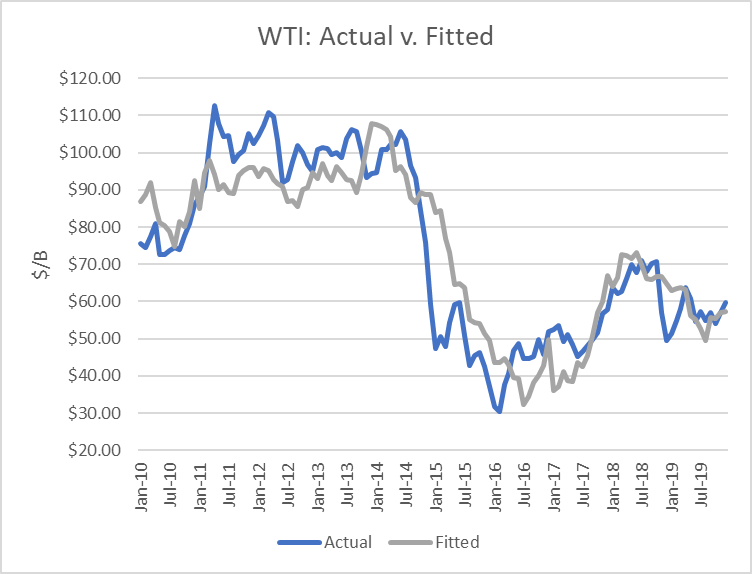The Energy Information Administration released its Short-Term Energy Outlook for September, and it shows that OECD oil inventories likely bottomed in this cycle in June 2018 at 2.804 billion barrels. Stocks peaked at 3.204 billion in May 2020. In September 2020, it estimated stocks dropped by 34 million barrels to end at 3.090 billion, 123 million barrels higher than a year ago.
The EIA estimated global oil production at 91.70 million barrels per day (mmbd) for September, compared to global oil consumption of 95.26 mmbd. That implies an undersupply of 3.56 mmbd or 110 million barrels for the month. About 76 million barrels of the draw for September is attributable to non-OECD stocks.
For 2020, OECD inventories are now projected to build by a net 87 million barrels to 2.967 billion. For 2021 it forecasts that stocks will draw by 46 million barrels to end the year at 2.921 billion.
The EIA forecast was made incorporates the OPEC+ decision to cut production and exports. According to OPEC’s press release:
Adjust downwards their overall crude oil production by 9.7 mb/d, starting on 1 May 2020, for an initial period of two months that concludes on 30 June 2020. For the subsequent period of 6 months, from 1 July 2020 to 31 December 2020, the total adjustment agreed will be 7.7 mb/d. It will be followed by a 5.8 mb/d adjustment for a period of 16 months, from 1 January 2021 to 30 April 2022. The baseline for the calculation of the adjustments is the oil production of October 2018, except for the Kingdom of Saudi Arabia and The Russian Federation, both with the same baseline level of 11.0 mb/d. The agreement will be valid until 30 April 2022; however, the extension of this agreement will be reviewed during December 2021.”
Oil Price Implications
I updated my linear regression between OECD oil inventories and WTI crude oil prices for the period 2010 through 2019. As expected, there are periods where the price deviates greatly from the regression model. But overall, the model provides a reasonably high r-square result of 79 percent.
I used the model to assess WTI oil prices for the EIA forecast period through 2020 and 2021 and compared the regression equation forecast to actual NYMEX futures prices as of October 14th. The result is that oil futures prices are presently overvalued through October 2020. However, futures prices are undervalued starting in November 2020 through the forecast horizon in 2021.
Uncertainties
April 2020 proved that oil prices can move dramatically based on market expectations and that they can drop far below the model’s valuations. In contrast, prices in May through September proved that the market factors in future expectations beyond current inventory levels.
The most important uncertainty is how deeply and how long the coronavirus will disrupt the U.S. economy. The U.S. has become the epi-center of the pandemic and is the largest economy and oil consumer globally.
Bill Gates, whose foundation is providing hundreds of millions of dollars in the effort to deploy vaccines and treatments once they become available, said that the fall is going to be worse than the summer in terms of transmissions of the virus. And the surge in coronavirus is forcing Europe to reinstate pandemic restrictions, which may cripple oil demand.
Total traveler throughput in U.S. airports remains more than 60% lower than a year ago, based on the latest data. And total petroleum demand figures were 12.6% lower than a year ago in the 4 weeks ending October 9th.
Though there is optimism about a vaccine being approved early next year, “It has not yet dawned on hardly anybody the amount of complexity and chaos and confusion that will happen in a few short months,” said Dr. Gregory Poland, the director of the Vaccine Research Group at the Mayo Clinic.
It is also unknown how much, if any, of the demand destruction will be permanent due to changes in business, such as online meetings instead of face-to-face meetings, work-at-home, and concerns about flying with infected people.
Conclusions
This pandemic is the biggest market-moving event in the modern history of the oil market. The uncertainties over if and when a safe and effective vaccine will become available are significant.
EIA’s October inventory forecast implies oil prices may rise above $50 in the near future and remain there through 2021, based on their supply/demand forecasts. However, forecasts given the unique uncertainties of a global pandemic are highly risky.
Check back to see my next post!
Best,
Robert Boslego
INO.com Contributor - Energies
Disclosure: This contributor does not own any stocks mentioned in this article. This article is the opinion of the contributor themselves. The above is a matter of opinion provided for general information purposes only and is not intended as investment advice. This contributor is not receiving compensation (other than from INO.com) for their opinion.





Why waste a good commentary about production, reserves and demand by including any of Bill Gates thoughts? He is no more capable of giving predictions on the Covid spread, infection rate or depth of the seasonal increase than Santa Claus! Rely upon sources that don’t stand to make billions by promoting fear and chaos to live his pockets. Demand will rise sharply and prices will follow. Covid is a flu and a infected hangnail is more deadly! The world is dying of economic collapse not Covid.
DON'T BE A FOOL AND TAKE THE,,,,,,,,, CV 10 SHOT